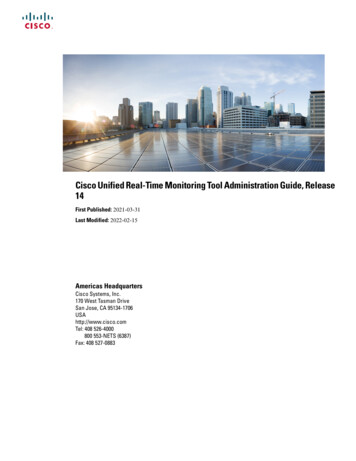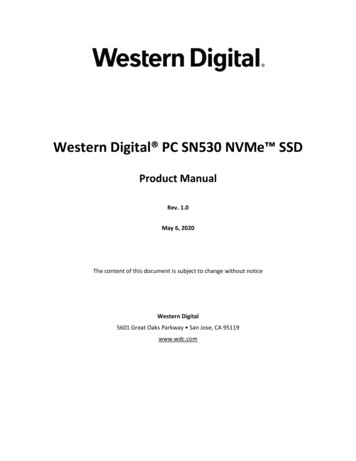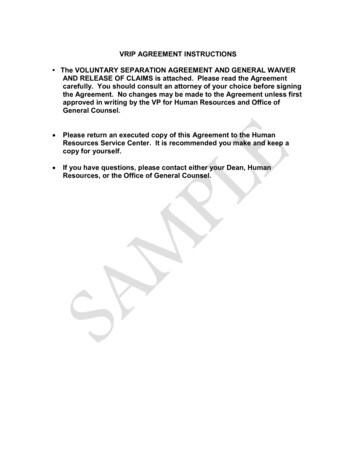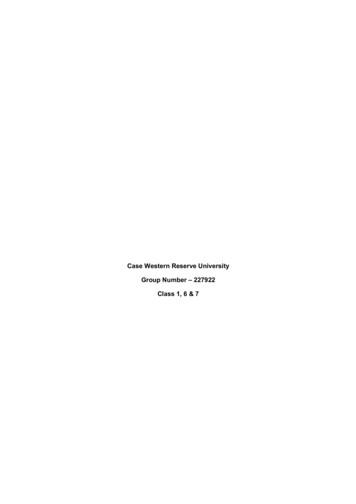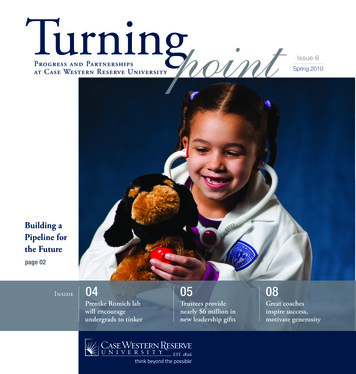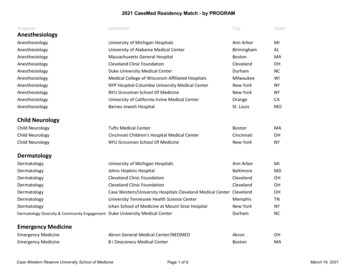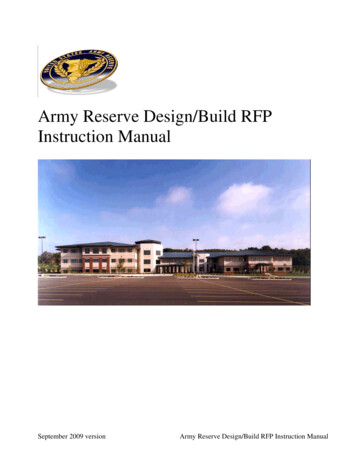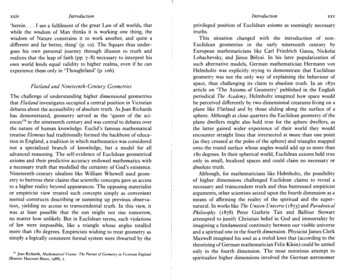
Transcription
IntroductionIntroduction'herein . I see a fulfilment of the great Law of all worlds, thatwhile the wisdom of Man thinks it is working one thing, thewisdom of Nature constrains it to work another, and quite adifferent and far better, thing' (p. 10). The Square thus under goes his own personal journey through illusion to truth andrealizes that the leap of faith (pp. 7-8) necessary to interpret hisown world lends equal validity to higher realms, even if he canexperience them only in 'Thoughtland' (p. 106).privileged position of Euclidean axioms as seemingly necessarytruths.This situation changed with the introduction of non Euclidean geometries in the early nineteenth century byEuropean mathematicians like Carl Friedrich Gauss, NickolaiLobachevsky, and Jinos B6lyai. In his later popularization ofsuch alternative models, German mathematician Hermann vonHelmholtz was explicitly trying to demonstrate that Euclideangeometry was not the only way of explaining the behaviour ofspace, thus challenging its claim to absolute truth. In an 1870article on 'The Axioms of Geometry' published in the Englishperiodical The Academy, Helmholtz imagined how space wouldbe perceived differently by two-dimensional creatures living on aplane like Flatland and by those sliding along the surface of asphere. Although at close quarters the Euclidean geometry of theplane dwellers might also hold true for the sphere dwellers, asthe latter gained wider experience of their world they wouldencounter straight lines that intersected at more than one point(as they crossed at the poles of the sphere) and triangles mappedonto the round surface whose angles would add up to more than180 degrees. In their spherical world, Euclidean axioms held trueonly in small, localized spaces and could claim no necessary orabsolute truth.Although, for mathematicians like Helmholtz, the possibilityof higher dimensions challenged Euclidean claims to reveal anecessary and transcendent truth and thus buttressed empiricistarguments, other scientists seized upon the fourth dimension as ameans of affirming the reality of the spiritual and the super natural. In works like The Unseen Universe (1875) and ParadoxicalPhilosophy (1878) Peter Guthrie Tait and Balfour Stewartattempted to justify Christian belief in God and immortality byimagining a fundamental continuity between our visible universeand a spiritual one in the fourth dimension. Physicist James ClerkMaxwell imagined his soul as a trefoil knot that (according to thetheorizing of German mathematician Felix Klein) could be untiedonly in the fourth dimension. The most notorious attempt tospiritualize higher dimensions involved the German astronomerXXIVFlatland and Nineteenth-Century GeometriesThe challenge of understanding higher dimensional geometriesthat Flatland investigates occupied a central position in Victoriandebates about the accessibility of absolute truth. As Joan Richardshas demonstrated, geometry served as the 'queen of the sci ences,16 in the nineteenth century and was central to debates overthe nature of human knowledge. Euclid's famous mathematicaltreatise Elements had traditionally formed the backbone of educa tion in England, a tradition in which mathematics was considerednot a specialized branch of knowledge, but a model for alladvanced reasoning. The self-evidence of Euclidean geometricalaxioms and their predictive accuracy endowed mathematics witha necessary truth that modelled the certainty of God's existence.Nineteenth-century idealists like William Whewell used geom etry to buttress their claims that scientific concepts gave us accessto a higher reality beyond appearances. The opposing materialistor empiricist view treated such concepts simply as convenientmental constructs describing or summing up previous observa tion, yielding no access to transcendental truth. In this view, itwas at least possible that the sun might not rise tomorrow,no matter how unlikely. But in Euclidean terms, such violationsof law were impossible, like a triangle whose angles totalledmore than 180 degrees. Empiricists wishing to treat geometry assimply a logically consistent formal system were thwarted by the16 Joan Richards, Mathematical Visions: The Pursuit ofGeometry in Victorian England(Boston: Harcourt Brace, 1988),2.XXV
I ntroductio nIntroductionFriedrich Zollner, who became convinced of the reality of thefourth dimension after being duped by the fraudulent tricks ofthe notorious spiritualist medium Henry Slade, like causing knotsto appear in a closed loop of string. In Transcendental Physics,which appeared in English translation in 1880, Zollner insistedthat the fourth dimension could explain notmanifestations but Christian miracles as welLAbbott's own theological objectives dictated a complicatedresponse to contemporary debates about Euclidean and non Euclidean space and the possibilities of higher dimensions. As amember of the Association for the Improvement of GeometricalTeaching, he joined forces with other educators in trying todevise pedagogical alternatives to Euclid's Elements. The experi ences that he has the Square undergo in Flatland certainlychallenged the privileged status of three-dimensional geometry.And in later works like The Spirit on the Waters, Abbott arguedexplicitly that whatever the predictive power of mathematics, itdid not allow us direct access to the divine. 17 Yet Abbott's ownpurposes were also served by some of the philosophical positionsstaked out by Euclid's supporters. Those who wanted to defendthe transcendental truth of Euclidean axioms stressed the distinc tion between being able logically to work out an understanding ofwhat alternative geometries might be like and being able actuallyto conceive or visualize their reality. For such idealists, a formalworking out of the properties of non-Euclidean geometries didnot challenge the privileged status of Euclidean space, which wasstill the only one conceivable given the perceptual limits imposedby our three-dimensional brains. Abbott endorsedtion in The Kernel and the Husk, noting that we cannot 'conceivespace of Four Dimensions . although we can perhapsdescribe what some of its phenomena would be if it existed' .18The inability of the kings of Pointland and Lineland to imagineworlds beyond their own are failures of 'conceiving' in this sense.The Sphere teaches the Square to reason out by analogy whatspatial reality would feel like in the third dimension, but it iswhen he physically lifts the Square into the next dimensionthe Flatlander can fully conceive this higher dimension. Oncereturned to Flatland, the Square experiences increasing difficultyin trying to reconstruct its reality in his mind. The fact thatmust finally depend upon faith (pp. 7-8) to affirm its existencesuggests that his analogical understanding of how Space1andmust operate does not give it a conceivable reality.And yet this leap of faith does not invalidate the Square'sexperiences, since for Abbott, geometrical truth depends on thesame acts ofimagination as do other forms of human understand ing and indeed formed a model for it. As his hypothetical geom eter argues in The Kernel and the Husk, no 'chalkland' trianglewas exactly equilateral, no chalkland point literally of one dimen sion. Although this mathematician had never seen a perfect circle,to him it was 'as real as a beefsteak and a pint of porter' in so far asit 'worked' to predict correctly the behaviour of reality. Heaccepted its existence 'by Faith' and believed that God 'intendedus to study this and other immaterial realities that our mindsmight approximate to His' (p. 32). Thus for Abbott, geometrywas a model for advanced reasoning not because it offered directaccess to truth, but because it depended on the same forms ofimagination that religion did. The Square's understanding ofhigher dimensions is affirmed in so far as it duplicates the strug gle through illusion to a grasp of higher reality that Abbott saw asthe providential course of all human cognition.It might seem likely that Abbott would make common causewith those who wished to use the fourth dimension to explainsupernatural phenomena. Several reviews of Flatland linked it tospiritualism, and at least one later work, Alfred Taylor Schofield'sAnother World, or, The Fourth Dimension, explicitly relied onFlatland's authority to buttress its own argument about the realityof the spirit world. 19 The Sphere's grudging admission thatXXVIEdwin Abbott Abbott, The Spirit on the Waters: The Evolution ofthe Divinefrom theHuman (London: Macmillan, dl(7), 32.'s Edwin Abbott Abbott, The Kernel and the Husk (London: Macmillan, 1886),259.17XXVll,Q See the reviews in The Athenaeum, Literary World, and Literary News for refer ences to spiritualism, and Alfred Taylor Schofield, Another World. or, The Fourth DImen sion (5th edn., London: Allen and Unwin, 1920), 3-4. Schofield's book was firstpublished in 1888 by Swan Sonnenschein.
IntroductionXXVlllbeings of a higher order had appeared in and disappeared fromSpaceland (p. IDS) suggests analogies to Christ's appearances afterthe resurrection, for instance, and in The Kernel and the Husk(p. 259) and The Spirit on the Waters (p. 31) Abbott acknowledgesthat beings from the fourth dimension could produce phenomenathat would lend themselves to such explanations. But for Abbott,religion was grounded upon the exercise of Christian virtues, notupon proof for miracles. Even if we could actually conceive of afourth dimension, 'we should not be a whit the better morally orspiritually' (Kernel and the Husk, 259); only the practice of faith,hope, and love can make us better people. Abbott consideredspiritualists to be as wrongheaded as Christian fundamentalistsfor insisting on too literal a proof of the supernatural. Like theSquare, who initially assumes that the Sphere must be a deitybecause of what appear to be his supernatural powers, bothgroups mistakenly assumed that phenomena that they could notexplain must necessarily have supernatural causes. Similarly,both sides in the empiricist/idealist debate were blinded by their'respective dimensional prejudices'-by their insistence eitherthat 'This can never be' or that 'It must needs be precisely thus,and we know all about it' (p. 10). In later works Abbott makesexplicit the relevance to his own age of the Square's final plea forintellectual modesty about what lies beyond experience. The wayto understand the spiritual essence of faith was 'to liberate ourthoughts from the yoke of materialism, and to take a more ampleview of the Universe', to allow for the possibility that a 'Thought land' of the spirit exists which is 'as much more real thanFactland as the land of three dimensions seems to us more realthan the land of twO,.20 Ultimately he valued non-Euclideangeometries not for the violations of our three-dimensional realitythat they allowed, but rather for the higher transcendental real ities that they could prepare us to imagine.20Abbott, Apologia (London: Black, 1(07), 83.
IOfthe Nature ofFlatlandI CALL our world Flatland, not because we call it so, but to makeits nature clearer to you, my happy readers, who are privileged tolive in Space.Imagine a vast sheet of paper on which straight Lines, Triangles,Squares, Pentagons, Hexagons, and other figures, instead ofremaining fixed in their places, move freely about, on or in thesurface, but without the power of rising above or sinking below it,very much like shadows---only hard and with luminous edges and you will then have a pretty correct notion of my country andcountrymen. Alas, a few years ago, I should have said 'my uni verse': but now my mind has been opened to higher views ofthings.In such a country, you will perceive at once that it is impossiblethat there should be anything of what you call a 'solid' kind; but Idare say you will suppose that we could at least distinguish bysight the Triangles, Squares, and other figures, moving about as Ihave described them. On the contrary, we could see nothing ofthe kind, not at least so as to distinguish one figure from another.Nothing was visible, nor could be visible, to us, except straightLines; and the necessity of this I will speedily demonstrate.Place a penny on the middle of one of your tables in Space; andleaning over it, look down upon it. It will appear a circle.But now, drawing back to the edge of the table, gradually loweryour eye (thus bringing yourself more and more into the condi tion of the inhabitants of Flatland), and you will find the pennybecoming more and more oval to your view; and at last when youhave placed your eye exactly on the edge of the table (so that youare, as it were, actually a Flatlander) the penny will then haveceased to appear oval at all, and will have become, so far as youcan see, a straight line.
16FlatlandThis WorldThe same thing would happen if you were to treat in the sameway a Triangle, or Square, or any other figure cut out of paste board. As soon as you look at it with your eye on the edge of thetable, you will find that it ceases to appear to you a figure, andthat it becomes in appearance a straight line. Take for example anequilateral Triangle--who represents with us a Tradesman of therespectable class. Fig. I represents the Tradesman as you wouldsee him while you were bending over him from above; figs. 2 and3 represent the Tradesman, as you would see him if your eye wereclose to the level, or all but on the level of the table; and if youreye were quite on the level of the table (and that is how we seehim in Flatland) you would see nothing but a straight line.shadows, we have none of the helps to the sight that you have inSpaceland. If our friend comes close to us we see his line becomeslarger; if he leaves us it becomes smaller: but still he looks like astraight line; be he a Triangle, Square, Pentagon, Hexagon, Circle,what you will-a straight Line he looks and nothing else.You may perhaps ask how under these disadvantageouscircumstances we are able to distinguish our friends from oneanother: but the answer to this very natural question will be morefitly and easily given when I come to describe the inhabitants ofFlatland. For the present let me defer this subject, and say a wordor two about the climate and houses in our country.\7(1) (2) (a)When J was in Spaceland I heard that your sailors have verysimilar experiences while they traverse your seas and discernsome distant island or coast lying on the horizon. The far-off landmay have bays, forelands, angles in and out to any number andextent; yet at a distance you see none of these (unless indeed yoursun shines bright upon them, revealing the projections andretirements by means of light and shade), nothing but a greyunbroken line upon the water.Well, that is just what we see when one of our triangular orother acquaintances comes towards us in Flatland. As there isneither sun with us, nor any light of such a kind as to make17
World2Ofthe Climate and Houses in FlatlandAs with you, so also with us, there are four points of the compassNorth, South, East, and West.There being no sun nor other heavenly bodies, it is impossiblefor us to determine the North in the usual way; but we have amethod of our own. By a Law of Nature with us, there is aconstant attraction to the South; and, although in temperateclimates this is very slight-so that even a Woman in reasonablehealth can journey several furlongs northward without muchdifficulty-yet the hampering effect of the southward attractionis quite sufficient to serve as a compass in most parts of our earth.Moreover the rain (which falls at stated intervals) coming alwaysfrom the North, is an additional assistance; and in the towns wehave the guidance of the houses, which of course have their side walls running for the most part North and South, so that theroofs may keep off the rain from the North. In the country, wherethere are no houses, the trunks of the trees serve as some sort ofguide. Altogether, we have not so much difficulty as might beexpected in determining our bearings.Yet in our more temperate regions, in which the southwardattraction is hardly felt, walking sometimes in a perfectly desolateplain where there have been no houses nor trees to guide me, Ihave been occasionally compelled to remain stationary for hourstogether, waiting till the rain came before continuing my journey.On the weak and aged, and especially on delicate Females, theforce of attraction tells much more heavily than on the robust ofthe Male Sex, so that it is a point of breeding, if you meet a Ladyin the street always to give her the North side of the way*-by nomeans an easy thing to do always at short notice when you are inrude health and in a climate where it is difficult to tell yourfrom your South.19Windows there are none in our houses: for the llght comes tous alike in our homes and out of them, by day and by night,equally at all times and in all places, whence we know not. Itwas in old days, with our learned men, an interesting andoft-investigated question, 'What is the origin of light?' and thesolution of it has been repeatedly attempted, with no other resultthan to crowd our lunatic asylums with the would-be solvers.Hence, after fruitless attempts to suppress such investigationsindirectly by making them liable to a heavy tax, the Legislature,in comparatively recent times, absolutely prohibited them. I alas I alone in Flatland-know now only too well the true solu tion of this mysterious problem; but my knowledge cannot bemade intelligible to a single one of my countrymen; and I ammockedthe sole possessor of the truths of Space and of thetheory of the introduction of Light from the world of ThreeDimensions-as if I were the maddest of the mad! But a truceof these painful digressions: let me return to our houses.The most common form for the construction of a house isfive-sided or pentagonal, as in the annexed figure. The twoNorthern sides RO, OF, constitute the roof, and for the most parthave no doors; on the East is a small door for the Women; on theWest a much larger one for the Men; the South side or floor isusually doorless.7?J.Square and triangular houses are not allowed, and for thisreason. The amdes of a Square (and still more those of an
20Flatlandequilateral Triangle) being much more pointed than those of aPentagon, and the lines of inanimate objects (such as houses)being dimmer than the lines of Men and Women, it follows thatthere is no little danger lest the points of a square or triangularhouse residence might do serious injury to an inconsiderate orperhaps absent-minded traveller suddenly running against them:and therefore, as early as the eleventh century ofour era, triangularhouses were universally forbidden by Law, the only exceptionsbeing fortifications, powder-magazines, barracks, and other statebuildings, which it is not desirable that the general public shouldapproach without circumspection.At this period, square houses were still everywhere permitted,though discouraged by a special tax. But, about three centuriesafterwards, the Law decided that in all towns containing a popu lation above ten thousand, the angle ofa Pentagon was the smallesthouse-angle that could be allowed consistently with the publicsafety. The good sense of the community has seconded the effortsof the Legislature; and now, even in the country, the pentagonalconstruction has superseded every other. It is only now and thenin some very remote and backward agricultural district that anantiquarian may still discover a square house.3Concerning the Inhabitants ofFlatlandTm: greatest length or breadth of a full-grown inhabitant ofFlatland may be estimated at about eleven of your inches. Twelveinches may be regarded as a maximum.Our Women are Straight Lines.Our Soldiers and Lowest Classes of Workmen are Triangleswith two equal sides, each about eleven inches long, and a baseor third side so short (often not exceeding half an inch) thatthey form at their vertices a very sharp and formidable angle.Indeed when their bases are of the most degraded type (notmore than the eighth part of an inch in size) they can hardlybe distinguished from Straight Lines or Women; so ex tremely pointed are their vertices. With us, as with you, theseTriangles are distinguished from others by being calledIsosceles; and by this name I shall refer to them in the followingpages.Our Middle Class consists of Equilateral or Equal-sidedTriangles.Our Professional Men and Gentlemen* are Squares (to whichclass I myself belong) and Five-sided figures or Pentagons.Next above these come the Nobility, of whom there are severaldegrees, beginning at Six-sided Figures, or Hexagons, and fromthence rising in the number of their sides till they receive thehonourable title of Polygonal, or many-sided. Finally when thenumber of the sides becomes so numerous, and the sides them selves so small, that the figure cannot be distinguished from acircle, he is included in the Circular or Priestly order; and this isthe highest class of all.It is a Law of Nature* with us that a male child shall have onemore side than his father, so that each generation shall rise (as aone step in the scale of development and nobility. Thus the
FlatlandThis Worldson of a Square is a Pentagon; the son of a Pentagon, a Hexagon;and so on.But this rule applies, not always to the Tradesmen, and stillless often to the Soldiers, and to the Workmen; who indeed canhardly be said to deserve the name of human Figures, since theyhave not all their sides equal. With them therefore the Law ofNature does not hold; and the son of an Isosceles (i.e. a Trianglewith two sides equal) remains Isosceles still. Nevertheless, allhope is not shut out, even from the Isosceles, that his posteritymay ultimately rise above his degraded condition. For, after along series of military successes, or diligent and skilful labours, itis generally found that the more intelligent among the Artisanand Soldier classes manifest a slight increase of their third sideor base, and a shrinkage of the two other sides. Intermarriages(arranged by the Priests) between the sons and daughters ofthese more intellectual members of the lower classes generallyresult in an offspring approximating still more to the type of theEqual-sided Triangle.Rarely-in proportion to the vast number ofIsosceles births is a genuine and certifiable Equal-sided Triangle produced fromIsosceles parents.! Such a birth requires, as its antecedents, notonly a series of carefully arranged intermarriages, but also a long continued exercise of frugality and self-control on the part ofthe would-be ancestors of the coming Equilateral, and a patient,systematic, and continuous development of the Isosceles intellectthrough many generations.The birth of a True Equilateral Triangle from Isosceles par ents is the subject of rejoicing in our country for many furlongsround. After a strict examination conducted by the Sanitary andSocial Board, the infant, if certified as Regular, is with solemnceremonial admitted into the class of Equilaterals. He is thenimmediately taken from his proud yet sorrowing parents andadopted by some childless Equilateral, who is bound by oathnever to permit the child henceforth to enter his former home orso much as to look upon his relations again, for fear lest thefreshly developed organism may, by force of unconscious imita fall back again into his hereditary level.The occasional emergence of an Isosceles from the ranks of hisserf-born ancestors, is welcomed not only by the poor serfs them selves, as a gleam of light and hope shed upon the monotonoussqualor of their existence, but also by the Aristocracy at large; forall the higher classes are well aware that these rare phenomena,while they do little or nothing to vulgarise their own privileges,serve as a most useful barrier against revolution from below.Had the acute-angled rabble been all, without exception, abso lutely destitute of hope and of ambition, they might have foundleaders in some of their many seditious outbreaks, so able as torender their superior numbers and strength too much for thewisdom even of the Circles. But a wise ordinance of Nature hasdecreed that, in proportion as the working-classes increase inintelligence, knowledge, and all virtue, in that same proportiontheir acute angle (which makes them physically terrible) shallincrease also and approximate to the harmless angle of the Equi lateral Triangle. Thus, in the most brutal and formidable of thesoldier class creatures almost on a level with women in their lackof intelligence-it is found that, as they wax in the mental abilitynecessary to employ their tremendous penetrating power toadvantage, so do they wane in the power of penetration itself.How admirable is this Law of Compensation! And how perfecta proof of the natural fitness and, I may almost say, the divineorigin of the aristocratic constitution of the States in Flatland!By a judicious use of this Law of Nature, the Polygons andCircles are almost always able to stifle sedition in its very cradle,taking advantage of the irrepressible and boundless hopefulnessof the human mind. Art also comes to the aid of Law and Order.It is generally found possible-by a little artificial compression orexpansion on the part of the State physicians-to make some ofthe more intelligent leaders of a rebellion perfectly Regular, andto admit them at once into the privileged classes; a much larger22I 'What need of a certifieate?' a Spaceland critic may ask: 'Is not the procreation of aSquare Son a certificate from Nature herself, proving the Equal-sidedness of theFather?' I reply that no Lady of any position will marry an uncertified Triangle. Squareoffspring has sometimes resulted from a slightly Irregular Triangle: but in almost everysuch case the Irregularity of the first generation is visited on the third; which either failsto attain the Pentao:onal rank, or relapses to the Triangular.23
24Flatlandnumber, who are still below the standard, allured by the prospectof being ultimately ennobled, are induced to enter the StateHospitals, where they are kept in honourable confinement for life;one or two alone of the more obstinate, foolish, and hopelesslyirregular are led to execution.Then the wretched rabble of the Isosceles, planless and leader less, are either transfixed without resistance by the small body oftheir brethren whom the Chief Circle keeps in pay for emer gencies of this kind; or else, more often, by means of jealousiesand suspicions skilfully fomented among them by the Circularparty, they are stirred to mutual warfare, and perish by oneanother's angles. No less than one hundred and twenty rebellionsare recorded in our annals, besides minor outbreaks numbered attwo hundred and thirty-five; and they have all ended thus.4Concerning the WomenIF our highly pointed Triangles of the Soldier class are formid able, it may be readily inferred that far more formidable are ourWomen. For, if a Soldier is a wedge, a Woman is a needle; being,so to speak, all point, at least at the two extremities. Add to thisthe power of making herself practically invisible at will, and youwill perceive that a Female in Flatland, is a creature by no meansto be trifled with.But here, perhaps, some of my younger Readers may ask how awoman in Flatland can make herself invisible. This ought, Ithink, to be apparent without any explanation. However, a fewwords will make it clear to the most unreflecting.Place a needle on a table. Then, with your eye on the level ofthe table, look at it side-ways, and you see the whole length of it;but look at it end-ways, and you see nothing but a point: it hasbecome practically invisible. Just so is it with one of our Women.When her side is turned towards us, we see her as a straight line;when the end containing her eye or mouth-for with us these twoorgans are identical-is the part that meets our eye, then we seenothing but a highly lustrous point; but when the back is pre sented to our view, then-being only sub-lustrous, and, indeed,almost as dim as an inanimate object-her hinder extremityserves her as a kind of Invisible Cap. *'rhe dangers to which we are exposed from our Women mustnow be manifest to the meanest capacity in Spaceland. If even theangle of a respectable Triangle in the middle class is not withoutits dangers; if to run against a Working Man involves a gash; ifcollision with an Officer of the military class necessitates a seriouswound; if a mere touch from the vertex of a Private Soldierbrings with it danger of death;-what can it be to run against aWoman, except absolute and immediate destruction? And when a
26FlatlandThis WorldWoman is invisible, or visible only as a dim sub-lustrous point,how difficult must it be, even for the most cautious, always toavoid collision!Many are the enactments made at different times in the differ ent States of Flatland, in order to minimize this peril; and in theSouthern and less temperate climates, where the force of gravita tion is greater, and human beings more liable to casual andinvoluntary motions, the Laws concerning Women are naturallymuch more stringent. But a general view of the Code may beobtained from the following summary: 1. Every house shall have one entrance in the Eastern side,for the use of Females only; by which all Females shall enter 'ina becoming and respectful manner'] and not by the Men's orWestern door.2. No Female shall walk in any public place without continuallykeeping up her Peace-cry* under penalty of death.3. Any Female, duly certified to be suffering from St. Vitus'sDance, * fits, chronic cold accompanied by violent sneezing, or anydisease necessitating involuntary motions, shall be instantlydestroyed.In some of the States there is an additional Law forbiddingFemales, under penalty of death, from walking or standing inany public place without moving their backs constantly fromright to left so as to indicate their presence to those behind them;oth
Flatland's authority to buttress its own argument about the reality of the spirit . world. . London: Allen and Unwin, 1920), 3-4. Schofield's book was first published in 1888 by Swan Sonnenschein. XXVlll Introduction . beings of a higher order had appeared in and disappeared from Spaceland (p. IDS) suggests analogies to Christ's appearances .

